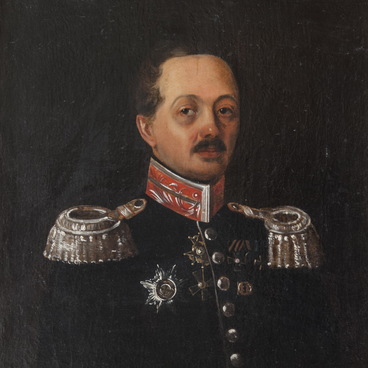Mikhail Boratynsky, a descendant of the ancient noble family of Boratynsky, donated, in 1919, a collection of family portraits to the Provincial People’s Museum.
Provincial as well as top-class artists painted the Boratynskys’ portraits. In the 1980s, the family portraits came to the All-Russia Art Research and Restoration Centre. It turned out that, apart from the usual damage, some additions had been made on the paintings — other artists added and restored some fragments between the second half of the 19th century and the beginning of the 20th century. Everything alien had to be removed from the picture. The experts also restored the peeled-off paint, the abrasions of the paint layer under the lacquer and the place where the canvas was torn.
This is a portrait of Pyotr Boratynsky — a full privy councilor, a military man and statesman of the end of the 18th — mid- 19th century. It was painted by an unknown artist who belonged to the circle of painter Vladimir Borovikovsky. The paintings by Borovikovsky and his followers were restrained in colors, the artists focused on textures, often depicting their models in indoor scenes.
The experts believe that, the portrait from the collection of the Tambov Regional Ethnography Museum is paired with the one of Ilya Boratynsky, one of Peter’ brothers. Borovikovsky himself created Ilya’s portrait. The paintings depict similar indoor scenes, and the brothers’ figures are facing each other. Peter’s portrait by an unknown artist is executed in a more rigid manner and the model’s figure and facial features are less detailed.
Pyotr Boratynsky is one of the sons of Andrei Boratynsky, the uncle of poet Evgeny Boratynsky. It is unknown whether he was born in 1770 or 1773. Pyotr served in the Semyonovsky Regiment’s Life Guards and was introduced to the heir to the throne, Tzarevitch Pavel, becoming a member of his retinue. He participated in the Russo-Swedish war fighting at Savitaipal in 1790. A year later, Boratynsky was transferred from the Guards to an infantry regiment and assigned to the Marine Cadet Corps to study marine sciences.
At the end of the 18th century, he participated in the maneuvers of the Baltic Fleet and was awarded the Order of St. Anna, IInd degree with diamonds and later promoted to the rank of Major General. During the 1812 Patriotic War with Napoleon, Peter ensured the evacuation of the Marine Corps and the Nautical School, and then enabled their return to St. Petersburg. From 1841 until his death in 1845, Pyotr Boratynsky served as a full privy councilor — one of the highest ranks in Russia’s Table of Ranks — to the Emperor Nicholas I.
Provincial as well as top-class artists painted the Boratynskys’ portraits. In the 1980s, the family portraits came to the All-Russia Art Research and Restoration Centre. It turned out that, apart from the usual damage, some additions had been made on the paintings — other artists added and restored some fragments between the second half of the 19th century and the beginning of the 20th century. Everything alien had to be removed from the picture. The experts also restored the peeled-off paint, the abrasions of the paint layer under the lacquer and the place where the canvas was torn.
This is a portrait of Pyotr Boratynsky — a full privy councilor, a military man and statesman of the end of the 18th — mid- 19th century. It was painted by an unknown artist who belonged to the circle of painter Vladimir Borovikovsky. The paintings by Borovikovsky and his followers were restrained in colors, the artists focused on textures, often depicting their models in indoor scenes.
The experts believe that, the portrait from the collection of the Tambov Regional Ethnography Museum is paired with the one of Ilya Boratynsky, one of Peter’ brothers. Borovikovsky himself created Ilya’s portrait. The paintings depict similar indoor scenes, and the brothers’ figures are facing each other. Peter’s portrait by an unknown artist is executed in a more rigid manner and the model’s figure and facial features are less detailed.
Pyotr Boratynsky is one of the sons of Andrei Boratynsky, the uncle of poet Evgeny Boratynsky. It is unknown whether he was born in 1770 or 1773. Pyotr served in the Semyonovsky Regiment’s Life Guards and was introduced to the heir to the throne, Tzarevitch Pavel, becoming a member of his retinue. He participated in the Russo-Swedish war fighting at Savitaipal in 1790. A year later, Boratynsky was transferred from the Guards to an infantry regiment and assigned to the Marine Cadet Corps to study marine sciences.
At the end of the 18th century, he participated in the maneuvers of the Baltic Fleet and was awarded the Order of St. Anna, IInd degree with diamonds and later promoted to the rank of Major General. During the 1812 Patriotic War with Napoleon, Peter ensured the evacuation of the Marine Corps and the Nautical School, and then enabled their return to St. Petersburg. From 1841 until his death in 1845, Pyotr Boratynsky served as a full privy councilor — one of the highest ranks in Russia’s Table of Ranks — to the Emperor Nicholas I.



